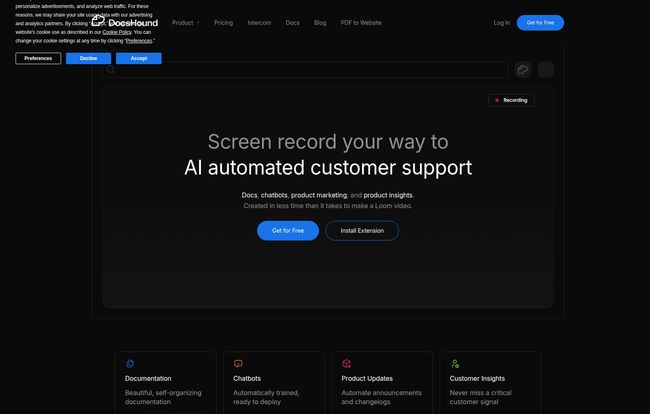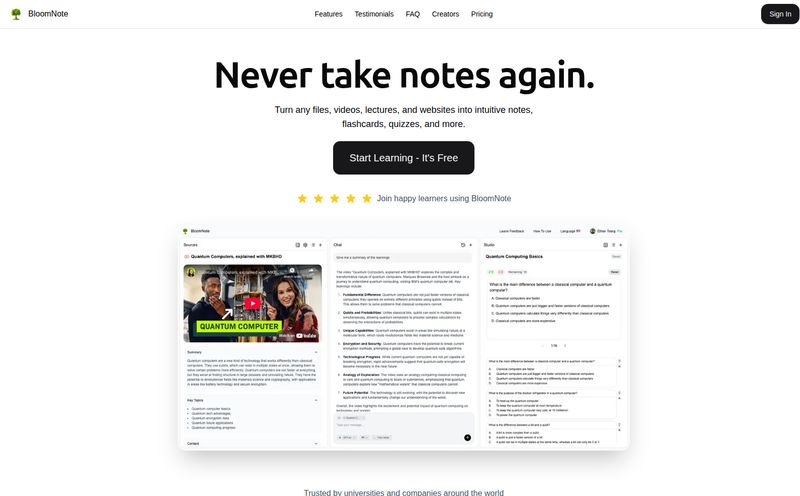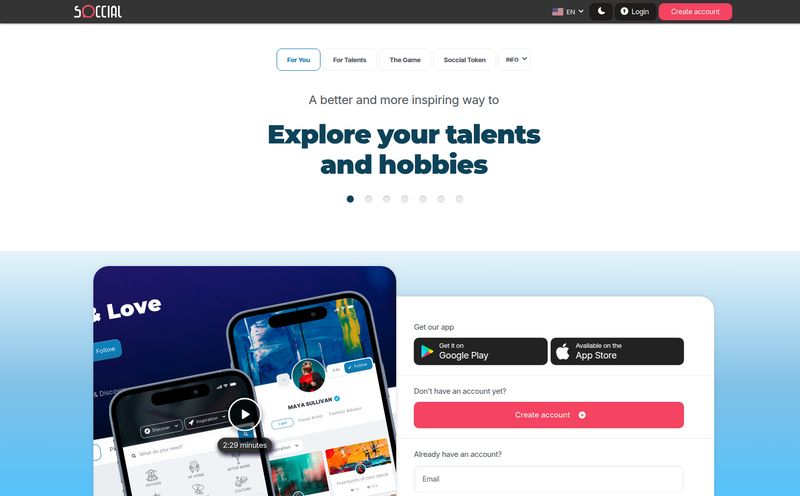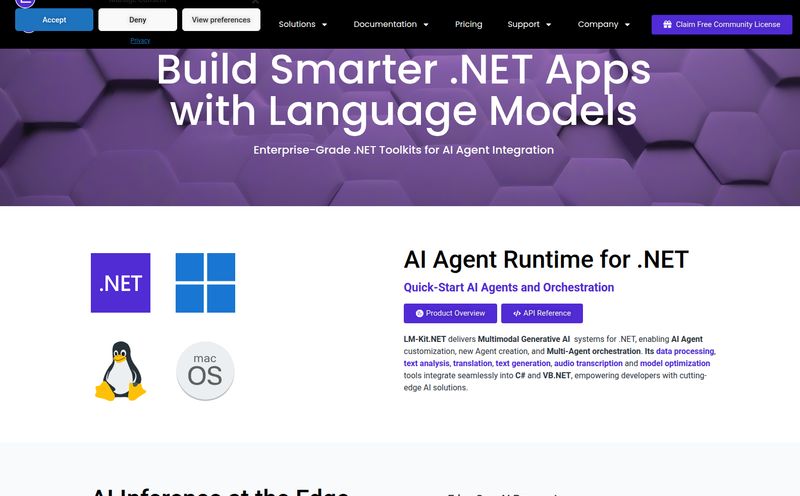If you’ve ever worked on a product team, you know the universal groan that echoes through Slack when someone says, “Alright, time to update the documentation.” It’s the digital equivalent of being told to clean your room. Necessary, vital even, but gosh, is it a slog.
For years, we’ve been stuck in this cycle: build a cool new feature, scramble to write a how-to guide, answer the same support tickets over and over, and then repeat the whole process two weeks later. It’s a time-suck. And as someone who lives and breathes traffic generation and user experience, I can tell you that bad (or non-existent) documentation is a silent killer of customer retention.
So, when I stumbled upon a tool called DocsHound, my professional curiosity was definitely piqued. The tagline on their site—“Screen record your way to AI automated customer support”—sounded almost too good to be true. An AI that watches you work and then… just writes the docs for you? And a chatbot? And gives you insights? Okay, you have my attention.
So, What Exactly is DocsHound?
Think of DocsHound as a magical, hyper-observant scribe that follows you around. But instead of a quill and parchment, it uses a Chrome extension and some pretty slick AI. You simply perform a task in your app, just like you would for a Loom video or a live demo, and DocsHound records it.
But here’s where it gets interesting. It doesn’t just give you a video. It analyzes your clicks, your movements, and the on-screen text to automatically generate step-by-step written guides, tutorials, and full-blown documentation. It turns a 5-minute demo into a polished knowledge base article in, well, about 5 minutes. The whole idea is to transform those everyday explanations we all do into living, breathing knowledge assets that work for you 24/7. Its a pretty compelling pitch, I have to admit.

Visit DocsHound
How It Works Without Voodoo Magic
I’m always skeptical of “AI magic,” but the process here is refreshingly straightforward. It boils down to a few simple steps:
- Record with the Chrome Extension: You install their extension, hit record, and walk through a process on your website or app. Nothing complicated here.
- The AI Gets to Work: Once you’re done, DocsHound’s visual learning AI takes over. It processes the recording, identifies the key actions, and structures it all into a coherent guide.
- Refine in the Editor: This isn't a black box. You get dropped into a visual editor where you can tweak the text, add notes, blur sensitive information, or merge steps. It's a powerfl editor that gives you final say, which is crucial. You’re not just handing over the keys to a robot.
From there, you can publish it to your knowledge base, use it to train an AI support agent, or just have it ready for the next time a customer asks, “how do I do that thing again?”
The Features That Made Me Look Twice
A lot of tools promise to save you time. But DocsHound seems to attack the problem from a few different, very smart angles.
Goodbye to Manual Doc Writing
This is the main event, right? The ability to automate documentation generation is huge. I’ve personally wasted entire days writing and formatting help articles. The thought of cutting that down to minutes is… exhilarating. It also means your documentation can actually keep pace with your development sprints. When a feature changes, you don’t have to dread rewriting a 10-page guide; you just do a quick new recording. That’s a massive win for agile teams.
A Chatbot That Isn't Completely Useless
Okay, we've all had infuriating experiences with terrible chatbots. “I’m sorry, I don’t understand the question.” Ugh. DocsHound’s approach is smarter because its AI chatbot is trained exclusively on the documentation you create. This means it's not just pulling from some generic internet database. It’s a specialist on your product. It answers questions based on the guides you literally just made. This creates a beautiful feedback loop: better docs lead to a better chatbot, which leads to fewer support tickets.
The Real Gold: Product Insights
Here’s the part that really interests me as a strategist. DocsHound doesn’t just stop at creating assets. It gathers data on how users interact with them. It can show you which guides are used most, what questions the chatbot struggles with, and where users are getting stuck. These are not just support metrics; they are pure product gold. This is the kind of data that helps you identify confusing UI, prioritize your next feature build, and create more effective marketing content. It turns your help center from a cost center into an intelligence-gathering machine.
Let’s Talk About The Price Tag
Alright, the all-important question: what’s this going to cost? DocsHound has a tiered pricing model that seems to cater to a pretty wide range of users, from solo creators to massive enterprises.
Here's a quick look at the plans:
| Plan | Price | Best For | My Quick Take |
|---|---|---|---|
| Basic | $0 / month | Personal projects | Perfect for trying it out. Limited, but you get a real feel for the core functionality. Can't complain about free. |
| Starter | $150 / month | Agile teams | This feels like the sweet spot for most small-to-medium SaaS businesses. You get the chatbot, more guides, and team collaboration. |
| Growth | $550 / month | Companies at scale | For larger companies where support volume is high. The weekly insights and advanced AI capabilities are the big draws here. |
| Enterprise | Custom Pricing | Industry leaders | You get the whole kitchen sink: custom integrations, dedicated support, the works. |
In my experience, that $150 for the Starter plan is very competitive. If it saves even one person on your team a few hours a week, it’s already paid for itself. The jump to $550 is significant, but for a company at that scale, the value of weekly product insights and unlimited guides could easily justify the cost.
The Good, The Bad, and The Honest Truth
No tool is perfect. While I'm genuinely excited about DocsHound's potential, let’s be balanced. The biggest pro is the sheer amount of time it saves. It’s an efficiency powerhouse that tackles a real, nagging pain point for so many companies. The added layers of the chatbot and product insights elevate it from a simple authoring tool to a strategic platform.
On the flip side, the Basic free plan is quite limited, as you'd expect. It’s a good demo, but you’ll need to upgrade for any serious team use. And for a very small startup or solo founder, that $150/mo on the Starter plan might still feel a bit steep. I also noticed that some integrations on their site are listed as “coming soon.” That’s not a dealbreaker—it shows they’re growing—but it's something to be aware of if you have a specific integration need right now.
Frequently Asked Questions About DocsHound
Is DocsHound hard to set up?
Not at all. From what I've seen, it's built around a simple Chrome extension. If you can install a browser extension and hit a record button, you’re pretty much good to go. The learning curve seems very low.
Can I edit the documentation the AI creates?
Yes, absolutely. This is a key feature. It gives you a first draft, but you have full control in their visual editor to refine, add context, or remove anything you don't want.
Does the AI chatbot work with other languages?
This is a great question. While the primary focus seems to be English, many AI platforms are expanding their language capabilities. You'd want to check with their support team for the most current list of supported languages.
Is my screen recording data secure?
Security is obviously a big concern. DocsHound mentions security on their website, and tools like this typically have robust policies. They offer features like blurring sensitive info, but I'd always recommend reviewing their specific security and privacy policies before recording sensitive company data.
Can I use it for internal team training?
Definitely. While the main pitch is for customer-facing support, this is a fantastic use case. You can quickly create internal SOPs, training guides for new hires, and how-tos for complex internal software.
My Final Take: Is DocsHound a Must-Have?
So, is DocsHound the magic bullet for all our documentation woes? Maybe not a magic bullet, but it’s a heck of a powerful weapon to add to your arsenal. It’s one of the smartest applications of AI for a real-world business problem I’ve seen in a while.
If you're a product manager, support lead, or founder who is constantly bogged down by the demands of creating and maintaining a knowledge base, you should give this a serious look. The ability to not only automate the creation but also glean actionable insights from it is, in my professional opinion, a game-changer.
It’s not just about writing docs faster. It’s about building a smarter, more scalable system for customer education and support. And that's something worth getting excited about.



